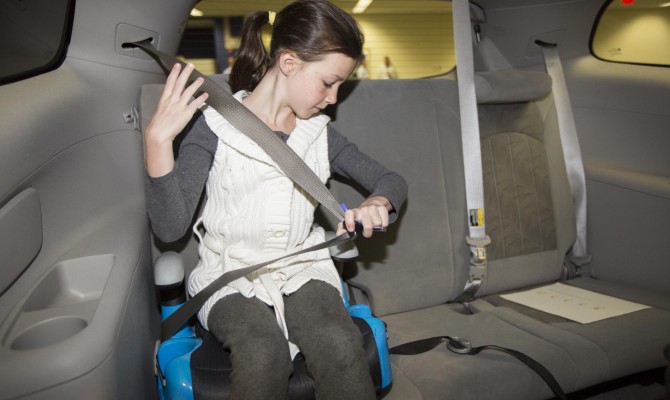Kids were asked to use smiley faces to compare and rate the ease of fastening the safety belt based on a five-point scale…
General Motors has put a new spin on ‘Take your child to work day’.
You can’t put them to work while they are learning what mom and dad do but they can be useful as experiment subjects. The so-called Human Factors group conducts about 100 studies globally into how people interact with their vehicles.
Having children around means group members can test such things as seat belts. No, they don’t crash test the cars but they do examine how easy it is for children to buckle up.
“Working with children on Take Your Child to Work Day is an excellent way for us to expand our pool of feedback,” said Don Shreves, GM Human Factors engineering group manager.
“Our group and research is very data-driven,” he said. “Designing every element to a vehicle comes down to millimetres. While a door handle placement or seat switch might feel right to the designing engineer, we come in with data points from real consumer feedback, including kids, to help determine the best location.”
This year during the special day, the Usability team conducted a study looking at the Buick Enclave’s third-row safety belt buckles. The kids were asked to use smiley faces to compare and rate the ease of fastening the safety belt based on a five-point scale.
A previous study dealt with a sickly problem that many of us have faced on trips with young offspring. In the early days of DVD players in cars, there were many kids forced to reach for the barf bag during a long journey. Not now and some credit must go to Shreves’ group who figured out how to place the screen outside of what they charmingly refer to as “the puke zone.”
Shreves explains, sensitively, “We know through other scientific research that even if our eyes are focused on a fixed point – if we can see the outside passing by in the window – our brain is telling us that we are moving.
“But if our eyes are at a downward angle and do not see the view outside the vehicle, our bodies become sensitive to motion and increase the chance of sickness.”
The team’s goal was to keep passenger’s eyes up and in a given spot. Determining that precise location required setting up a DVD screen on a track that could slide fore and aft along the roof of an Enclave.
Researchers recorded the responses of more than 75 kids who were asked when the screen distance was too close and too far away.
From there, the data was graphed and compiled to determine the best location. The results were turned over to the vehicle engineering team to integrate into the Enclave’s design.
Recent Comments
- { Enjoyed your Forest of Bowland in the BMW X5M, particularly the photo of the BMW in front of the main part of Stonyhurst College where... }
- { Bantam designed the Jeep, not Willy's or Ford. The American military gave the original Bantam prototype to Willys and Ford to copy. There is plenty... }
- { All Escalades come with a 6.2-lilter V8 engine that produces 420 horsepower. A six-speed automatic is the only transmission offered and drives the rear wheels.... }
- { Alexandra is an excellent journalist. }
Popular Posts
- Journey to a ‘Sparkling’ Luxury Okanagan Resort “Four lucky readers will put a Dodge Journey’s weekend-...
- The Need For Speed: Hike Those Highway Limits More than half of those polled believe the province sho...
- Drives-U-Crazy… Erratic drivers. An early morning drive from Kelowna to Vancouver is nor...
- Readers Respond: The Pros and Cons of Increasing B.C. Speed Limits Increasing the speed limits will only increase risk to...
- Honda CR-V Review: The Compact Crossover To Get Things Done The CRV is a very stylish and aerodynamic crossover veh...







